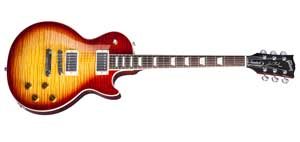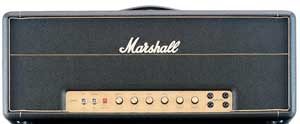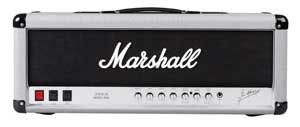The man, the myth, the top hat. Is there anyone out there who doesn’t know who Slash is? The guitar-playing community certainly knows, and I’d say it’s fair to claim that he’s extremely well known far beyond our our little circle. Along with his ubiquity, I would argue that he’s got to be one of the most polarizing guitarists of the last few decades — people seem to either love him or hate him. Yet despite all his fame, I would forgive you for forgetting that he’s one heck of a guitarist and is showing no signs of slowing down. He’s been in Guns N’ Roses, Velvet Revolver, his own Slash’s Snakepit, and many other acts as the lead guitarist. Not one to shy away from session work, Slash has lent his riffs and licks to countless songs and albums by other artists.
Les Paul
Throughout the decades Slash has been active, he’s been playing a Gibson Les Paul through a Marshall stack. Just put the needle down on Appetite for Destruction and you’ll instantly be introduced to that signature crunch, a tone he has only subtly varied throughout his career. A good chunk of his playing is done on the bridge pickup, as can be clearly heard when doing some palm-muted riffs. The low end stays tight, the mids are rich and up-front, and the highs are searing with just the right amount of crispiness to them. Solos are pretty evenly split between both pickups, but when he flicks the pickup selector to Rhythm, prepare yourself for just how incredibly smooth it sounds. The fatness of the neck pickup is complemented with a rich, singing sustain that sounds about as good as a Les Paul can. Just listen to the beginning of “Sweet Child O’ Mine” — that tone is so sweet it could give you a toothache.
Marshall
Great tone, sure, but that Les Paul doesn’t make all that wonderful noise by itself. For the recording of Appetite for Destruction, the infamous story goes that Slash used a rented a Marshall 1959 Super Lead from S.I.R. After the sessions, he loved the amp so much that he never returned it, telling the rental company it had been stolen. All good things must come to an end, however, and an uninformed roadie accidentally brought the amp back to S.I.R. It’s pretty easy to hear why Slash loved this amp. The overdrive is crunchy and present, but maintains a huge dynamic range. If he plays soft on the cranked Marshall, it cleans up with just a touch of dirt, but as he digs in the distortion gets incredibly saturated, giving the leads a glassy tone and supercharging the rhythm playing with just the right amount of attitude.
Slash later became known as a Marshall Jubilee player. In the ’80s, modding Marshall amps was all the rage. Super Leads were given master volume knobs, more gain stages were added, and a plethora of other ideas — basically if you could imagine it, there was an amp tech out there willing to try it. In 1987, Marshall released the Silver Jubilee model, and many have viewed the design as a response to the modding craze happening at the time. The Jubilees are essentially hot-rodded JCM 800s, packing a ton of features into the same chassis, but covering it in mirror chrome and silver tolex. With an extra (footswitchable!) gain boost on tap, as well as an effects loop and a half-power switch, the Jubilee gave Slash the extra bit of gain he needed to get his tone really cooking. Slash is so closely associated with the Jubilee, that in 1996 Marshall created the JCM Slash 2555 — Marshall’s first signature amp — mirroring the Jubilee in almost every feature, except for the modern gold and black Marshall color scheme.
While its easy to get caught up in gear when trying to emulate your favorite players’ sounds, most of the tone undoubtedly comes from how the player handles the instrument. Working on your technique is invaluable to your own playing, let alone when you want to take on the tone of a rock star. That being said, Slash’s tone comes from the marriage of a Les Paul and a Marshall — make no mistake about it! If you’re looking for a place to start, picking up these two components are a must.




